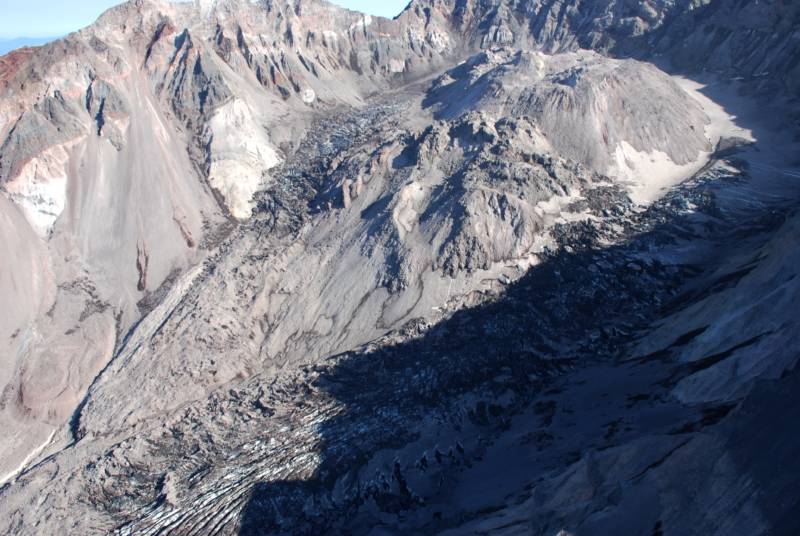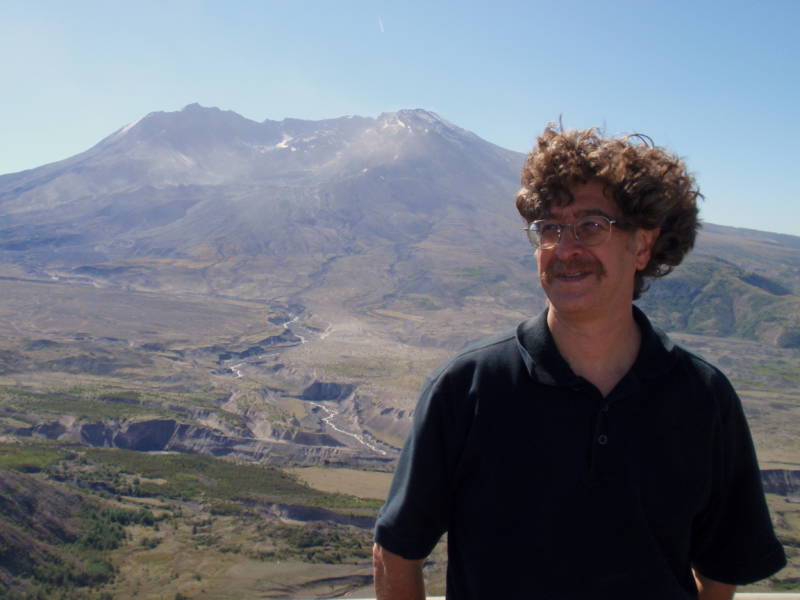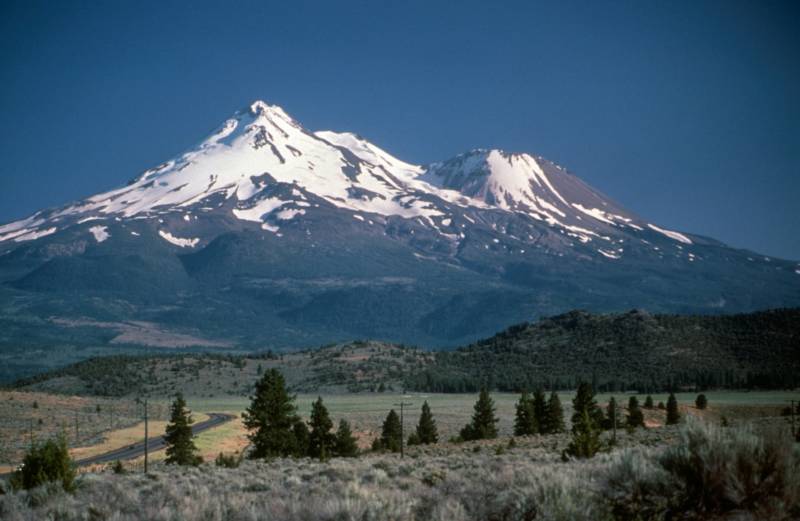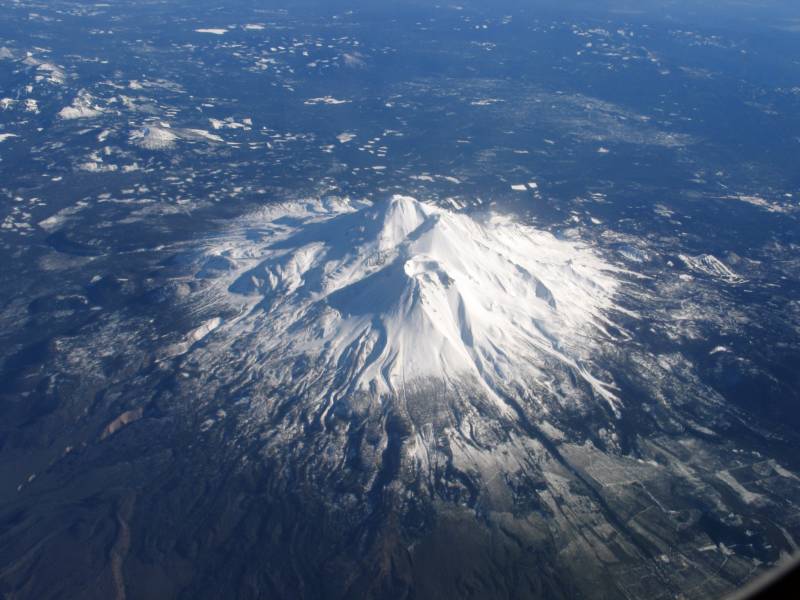
We’re entering the best time of year for fans of glaciers. The high-country rivers of ice are getting their annual nourishment from winter’s snows–probably not enough, as Yosemite National Park geologist Greg Stock tells us: “Glaciers are getting about the same amount of snowfall each winter but they’re seeing a lot more melt in summertime because of those warmer temperatures.”
A database called Glaciers of the American West posits that, “Perhaps glaciers are the clearest expression of climate change.” But within that National Science Foundation-funded database can be found a few growing glaciers–curious exceptions that buck the general melting trend. Cherry-picking those exceptions allows some global warming skeptics to suggest we should be preparing for the next ice age (see here and here for examples of this). However, a closer examination of the anomalous glaciers suggests that unique circumstances are more likely at work.

Crater Glacier on Mount St. Helens in southwest Washington State is a dramatic example of a growing glacier. The glacier formed in the shaded recesses of the high elevation crater left by the catastrophic 1980 eruption of the volcano. USGS research hydrologist Joe Walder told us the mass of ice and rock is advancing some 300 feet per year. This time lapse video (file will download) provided by the U.S. Geological Survey shows why glaciers are also known as “rivers of ice.”
Another view from above shows how Crater Glacier got squeezed and pushed around when Mount St. Helens reawakened in 2006 and extruded a new lava dome. That the young glacier survived the renewed eruption is remarkable by itself. The fact that the horseshoe-shaped glacier is gaining mass indicates just what a perfect setting Mother Nature created at the volcano. The north-facing crater acts like a catcher’s mitt reaching toward the moist jet stream.
Mount Rainier, also in Washington State, is the most heavily glaciated peak in the Lower 48 states. On Rainier’s east flank, Emmons Glacier is advancing. The National Park Service offers this myth-busting explanation:
“The Emmons Glacier experienced a rock avalanche in 1963, which covered part of the glacier with a layer of rock debris. This debris now insulates the ablation (melting) zone of the glacier from sunlight and warm air temperatures and the melting of the glacier is smaller than from an otherwise clean glacier. Because melting is reduced, but the ice flow is the same, the glacier is advancing. This response has nothing to do with climate change.”

Something yet again different appears to be happening at northern California’s Mount Shasta. A research team from UC Santa Cruz documented 50 years of nearly continuous expansion of the two largest glaciers on Mount Shasta. The researchers theorize in the journal Climate Dynamics that Shasta’s glaciers are benefiting from a warming Pacific Ocean. A warmer ocean means more evaporation, and hence more moisture blows over the high peaks near the coast. Because of Shasta’s height, the enhanced precipitation mostly falls as snow, adding to the mass of the glaciers.
Portland State University glaciologist Andrew Fountain says no one has yet explained to his satisfaction why glaciers on peaks immediately to the north and south of Mount Shasta are not likewise growing. It is as if a “snow gun” is aimed directly at Shasta’s 14,162-foot summit. But he doesn’t lose sleep over that issue because Fountain and the other glaciologists who have studied Shasta do not expect the glacial advance to last. Their climate models call for the snow level (elevation) to rise.
“We do expect it to be a temporary phenomenon,” Fountain said. “The modeling done down on Mount Shasta expects the glaciers to retreat within the next decade or so, if they’re not already.”
Tom Banse’s radio feature on the West’s growing glaciers airs Monday morning on The California Report.
8 thoughts on “Some Glaciers Buck the Trend”
Comments are closed.

You might also want to show the “glacier mass balance” graph – which effectively conveys the big picture – at
http://tamino.files.wordpress.com/2007/05/glacemb.jpg
(from the Open Mind “Graphic Evidence” post at http://tamino.wordpress.com/2007/09/05/graphic-evidence/ )
I went on a field trip to Little Round Top lake, which is about 20 miles due South of Lake Tahoe.
August 29th but there were still plenty of snow and ice fields in the lee of the mountain. The temp was about 70 degrees. I enjoyed it immencely.
Never going up there in the winter again.
Once you go for the summer snow it ruins you for the cold.
Maybe next time you can write up the glaciers of the West that are retreating. You need a baseline to establish there is a trend.
Ah, the models are showing the glacier retreat! What are the modeling saying about those glaciers that are advancing. I am wondering if the scientists would share their models? We discovered that the models used by CRU were filled with fudge factors to get the desired results. It might be interesting to take a look a these models and see what the in- put and out put factors are? Are they tuned to get the desired results or do they inn fact model the real world as we know it?
Sounds like most of the glaciers are doing just fine but you sound so disappointed why?
30 Nov 2009
Global warming “naysayers” like to point to contradictions, such as the fact that a few glaciers are expanding, as evidence that global warming is a hoax. Yet the overwhelming trend is that throughout the world, many glaciers have significantly melted away. And this change coincides with the drastic increases in atmospheric CO2 concentration in a geologically short time-frame of only about one hundred years. It makes sense that increased ocean warming would lead to more precipitation in certain areas, such as Mount Shasta.
The Himilayian glaciers are expanding as well, contrary to earlier reports they were not but the Artic ice is also back to normal and Antartica was never an issue as its been expanding for years. Just don’t see a big issue with the glaciers, these are the most prominent in the US and if all are expanding which are not ????
Being in Fla, I did hear that the ski resorts were buried and open earlier than ever before so the Sierra and CO snow pack should be pretty good, still don’t see a big problem???
I’d still like to see some of the western glaciers that are retreating.
It’ll be fun. I’m particularly interested in what the tone of the author’s disclaimer will be.
Angle of the “catcher’s mitt”, aim of the “snow-gun” a bit off.
Stuff like that.
You think, Michael Mann, the lead author of Real Climate will be brought up on fraud charges, after the investigation?
Mr Sullivan
“Global warming “naysayers” like to point to contradictions”
Well not sure how to repond but if Glaciers are expanding but are contracting that is a contradicion of rather epic purporsions that you shouldn’t have to be a “naysayer” to realize. As far as a rock slide, wouldn’t that make the surface darker? thereby creating more warming by absorbing more heat – wondering, honest
kind like its warming but actually getting colder is kinda another one.